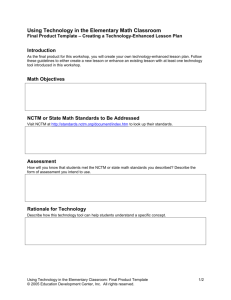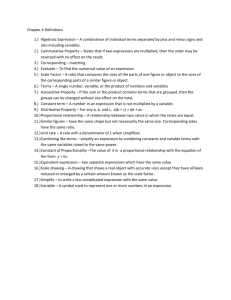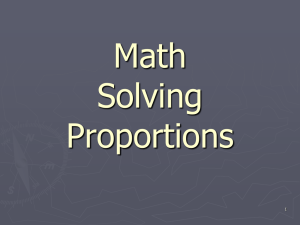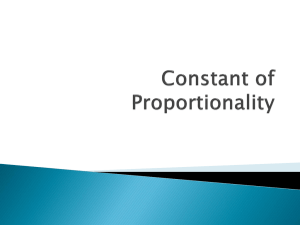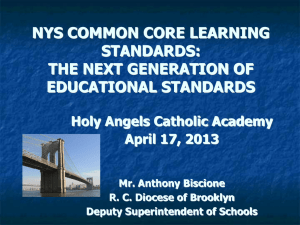Common Core State Standards
advertisement
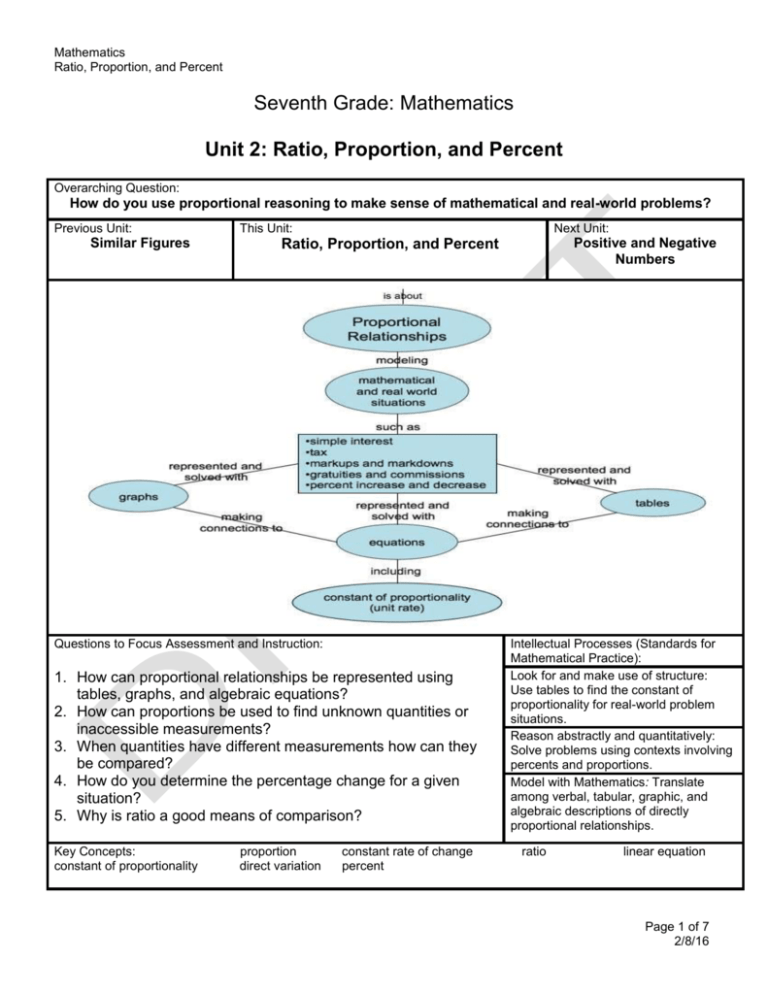
Mathematics Ratio, Proportion, and Percent Seventh Grade: Mathematics Unit 2: Ratio, Proportion, and Percent Overarching Question: How do you use proportional reasoning to make sense of mathematical and real-world problems? Previous Unit: Similar Figures This Unit: Next Unit: Questions to Focus Assessment and Instruction: 1. How can proportional relationships be represented using tables, graphs, and algebraic equations? 2. How can proportions be used to find unknown quantities or inaccessible measurements? 3. When quantities have different measurements how can they be compared? 4. How do you determine the percentage change for a given situation? 5. Why is ratio a good means of comparison? Key Concepts: constant of proportionality Positive and Negative Numbers Ratio, Proportion, and Percent proportion direct variation constant rate of change percent Intellectual Processes (Standards for Mathematical Practice): Look for and make use of structure: Use tables to find the constant of proportionality for real-world problem situations. Reason abstractly and quantitatively: Solve problems using contexts involving percents and proportions. Model with Mathematics: Translate among verbal, tabular, graphic, and algebraic descriptions of directly proportional relationships. ratio linear equation Page 1 of 7 2/8/16 Mathematics Ratio, Proportion, and Percent Unit Abstract Students studied rates and ratios in sixth grade. In this unit, students reason proportionally. They use ratios as a basis of comparison between two sets of data. They observe related data in the form of a table and look for patterns connecting these data values. Plotting the paired data points to see a graphical representation, and writing an equation that shows the relationship of the data in the table further strengthens this understanding. When the change observed in the table is constant, students connect to a linear graph. This demonstrates a proportional relationship across multiple representations and deepens the understanding of these characteristics. The unit rate studied in grade six is now a focus of rate of change used in writing linear equations in grade seven. Other concepts in this unit include solving problems to find an unknown part of a proportion and applying proportional reasoning to real-world contexts. Students think proportionally in such situations as calculating sales taxes, interest, and commissions; scale drawings; and unit pricing. Common Core State Standards Ratios and Proportional Relationships (7.RP)________________________________________ Analyze proportional relationships and use them to solve real-world and mathematical problems. 1. Compute unit rates associated with ratios of fractions, including ratios of lengths, areas and other quantities measured in like or different units. For example, if a person walks 1/2 mile in each 1/4 hour, compute the unit rate as the complex fraction 1/2/1/4 miles per hour, equivalently 2 miles per hour. 2. Recognize and represent proportional relationships between quantities. a. Decide whether two quantities are in a proportional relationship, e.g., by testing for equivalent ratios in a table or graphing on a coordinate plane and observing whether the graph is a straight line through the origin. b. Identify the constant of proportionality (unit rate) in tables, graphs, equations, diagrams, and verbal descriptions of proportional relationships. c. Represent proportional relationships by equations. For example, if total cost t is proportional to the number n of items purchased at a constant price p, the relationship between the total cost and the number of items can be expressed as t = pn. d. Explain what a point (x, y) on the graph of a proportional relationship means in terms of the situation, with special attention to the points (0, 0) and (1, r) where r is the unit rate. 3. Use proportional relationships to solve multistep ratio and percent problems. Examples: simple interest, tax, markups and markdowns, gratuities and commissions, fees, percent increase and decrease, percent error. 4. Use ratios, fractions, differences, and percents to form comparison statements in a given situation, such as: “Which model of car has the best fuel economy?”, “What percent of girls play basketball?”, “What is the ratio of boys to girls?”. 5. Decide when the most informative comparison is the difference between two quantities and when it is a ratio between pairs of quantities. For example, should Biggest Loser contestants Page 2 of 7 2/8/16 Mathematics Ratio, Proportion, and Percent be judged on the amount of pounds lost, or the percent of body weight lost? Expressions and Equations (7.EE)_________________________________________________ Use properties of operations to generate equivalent expressions. 1. Apply properties of operations as strategies to add, subtract, factor, and expand linear expressions with rational coefficients. 2. Understand that rewriting an expression in different forms in a problem context can shed light on the problem and how the quantities in it are related. For example, a + 0.05a = 1.05a means that “increase by 5%” is the same as “multiply by 1.05.” Solve real-life and mathematical problems using numerical and algebraic expressions and equations. 3. Solve multi-step real-life and mathematical problems posed with positive and negative rational numbers in any form (whole numbers, fractions, and decimals), using tools strategically. Apply properties of operations to calculate with numbers in any form; convert between forms as appropriate; and assess the reasonableness of answers using mental computation and estimation strategies. For example: If a woman making $25 an hour gets a 10% raise, she will make an additional 1/10 of her salary an hour, or $2.50, for a new salary of $27.50. If you want to place a towel bar 9 3/4 inches long in the center of a door that is 27 1/2 inches wide, you will need to place the bar about 9 inches from each edge; this estimate can be used as a check on the exact computation. 4. Use variables to represent quantities in a real-world or mathematical problem, and construct simple equations and inequalities to solve problems by reasoning about the quantities. Geometry (7.G)_________________________________________________________________ Draw, construct, and describe geometrical figures and describe the relationship between them. 1. Solve problems involving scale drawings of geometric figures, including computing actual lengths and areas from a scale drawing and reproducing a scale drawing at a different scale. Instructional Resources NCTM Illuminations (http://illuminations.nctm.org) Constant Dimension: Students will measure the length and width of a rectangle using both standard and non-standard units of measure. In addition to providing measurement practice, this lesson allows students to discover that the ratio of length to width of a rectangle is constant, in spite of the units. For many middle school students, this discovery is surprising. http://illuminations.nctm.org/LessonDetail.aspx?id=L572 Understanding Rational Numbers and Proportion: In this lesson, students use real-world models to develop an understanding of fractions, decimals, unit rates, proportions, and problem solving. The three activities in this investigation center on situations involving rational numbers and proportions that students encounter at a bakery. Page 3 of 7 2/8/16 Mathematics Ratio, Proportion, and Percent http://illuminations.nctm.org/LessonDetail.aspx?id=L284 Bagel Algebra: A real-life example—taken from a bagel shop, of all places—is used to get students to think about proportional reasoning. Students must decipher a series of equations and interpret results to understand the point that the bagel shop’s owner is trying to make. http://illuminations.nctm.org/LessonDetail.aspx?id=L662 Measuring Up: This unit explores the concepts of proportional reasoning, ratio, and indirect measurement. Students engage in a variety of activities that involve taking their own measurements, exploring different ratios, and examining similar figures. Students convert measurements in to customary and metric units. These activities immerse students in problem solving, reasoning, and making connections to real-life situations. http://illuminations.nctm.org/LessonDetail.aspx?ID=L511 Scaling Away: Students will measure the dimensions of a common object, multiply each dimension by a scale factor, and examine a model using the multiplied dimensions. Students will then compare the surface area and volume of the original object and the enlarged model. http://illuminations.nctm.org/LessonDetail.aspx?id=L584 Walk the Plank: When one end of a wooden board is placed on a bathroom scale and the other end is suspended on a textbook, students can "walk the plank" and record the weight measurement as their distance from the scale changes. The results are unexpected— the relationship between the weight and distance is linear, and all lines have the same x‑ intercept. This investigation leads to a real world occurrence of negative slope, examples of which are often hard to find. http://illuminations.nctm.org/LessonDetail.aspx?id=L682 Texas Instruments Step Up: In this activity, students will explore the concept of slope. They will measure the vertical height (rise) and horizontal length (run) of a set of stairs then find the ratio to describe the steepness. A graph will then be created to show the relationship . http://education.ti.com/calculators/timiddlegrades/US/Activities/Detail?s=Math&id=13 647 What’s Your Benchmark: This activity introduces students to the importance of benchmarks when estimating measurements. Students will also use the Convert menu to change from one unit to another. http://education.ti.com/calculators/timiddlegrades/US/Activities/Detail?s=Math&id=12 291 Two Friends’ Methods: Students will investigate the decrease in items as a percent change while considering several methods for calculating percent change. They will also develop a procedure that can be repeated to solve problems. http://education.ti.com/calculators/downloads/US/Activities/Detail?id=8458&ref=%2fc alculators%2fdownloads%2fUS%2fActivities%2fSearch%2fSubject%3fs%3d5022%2 6sa%3d1008%26t%3d1130%26d%3d1%26size%3d15%26page%3d4 Other Resources Calculation Nation: The games of Calculation Nation® are organized around content from the upper elementary and middle grades math curriculum. By becoming a citizen of Calculation Nation®, your child or student will play online math strategy games that allow Page 4 of 7 2/8/16 Mathematics Ratio, Proportion, and Percent them to learn about fractions, factors, multiples, symmetry and more, as well as practice important skills like basic multiplication and calculating area — all while having fun. http://calculationnation.nctm.org/ Figure This! Math Challenges for Families has a variety of problems for students to solve. There is a Math Index, which sorts the problems by math content. http://www.figurethis.org/index.html Middle School Portal: The problems here deal with ratio, in the concrete as well as the abstract. Seventh grade students will make actual scale models with paper or clay and find percentages in real-world situations. But they will also work hands-on with online images that make visual the abstractions of ratio and percentage. http://msteacher.org/epubs/math/math15/ratio.aspx Math Forum: Clearinghouse of ratio and proportion activities for 7th grade. http://mathforum.org/mathtools/cell/m7,9.10,ALL,ALL/ Math.com: An online lesson with explanation, examples, and practice problem. Topics include ratio, proportion, distance -rate-time, and similar figures. A unit assessment is also included. http://www.math.com/school/subject1/lessons/S1U2L1GL.html Ratios for All Occasions: Features resources on the concept of the ratio as encountered in middle school: as rates in real-world problems, percents in relation to fractions, scale factors in building models, and comparisons of lengths in geometry. Most of these digital resources are activities that can serve as supplementary or motivational material. http://msteacher.org/epubs/math/ratios/math.aspx Scale Drawings Resources: This resource provides twenty-four different activities for use with middle school students to allow them to experience scale factors (dilations) in realworld contexts. http://msteacher.org/return_list_math.aspx?id=366 Proportional Relationships and Unit Rates: The activities that follow interpret proportional relationships using a unit-rate approach. http://www.cehd.umn.edu/rationalnumberproject/89_4.html TEXTEAMS Rethinking Middle School Mathematics: Proportionality Trains: Investigate properties of proportional relationships using tables, graphs, and equations. http://math.springbranchisd.com/middle/resources/proportionality/trains.pdf Restless Rectangles: Investigate the constants of proportionality within similar shapes as “shape ratios” and the scale factors between pairs of similar shapes as “size ratios” for a set of similar rectangles and use these ratios to solve problems. http://math.springbranchisd.com/middle/resources/proportionality/restless_rectangles.pdf Jet Ski Rental: Distinguish between a proportional and non-proportional situation using the Page 5 of 7 2/8/16 Mathematics Ratio, Proportion, and Percent characteristics of a proportional relationship. http://www.pasadenaisd.org/Curr_Instr/math/images/6th%20Grade/3rd%20Six%20W eeks/Proportionality/jetskirental.pdf Lost and Gained: Use ratios and unit rates as conversion factors between measurement units and rates. http://www.crowley.k12.tx.us/curriculum_and_instruction/Math/7TH/data_files/TT_Acti vities/lostandgained.pdf Professional Resources NCTM (www.nctm.org) Yearbook: NCTM's 2002 Yearbook emphasizes that although fractions, ratios, and proportions are pivotal concepts in the middle school, their development and understandings begin in the elementary school. The companion booklet presents activities that illustrate some of the ideas in the yearbook and that go beyond the content of the yearbook itself. Teachers' notes and handouts are designed to bring the yearbook to life in the classroom. http://www.nctm.org/catalog/product.aspx?ID=12244 Essential Understanding Series: Developing Essential Understanding of Ratios, Proportions, and Proportional Reasoning for Teaching Mathematics: Grades 6-8. This book goes beyond a simple introduction to ratios, proportions, and proportional reasoning. It will help broaden and deepen your mathematical understanding of one of the most challenging topics for students. http://www.nctm.org/catalog/product.aspx?ID=13482 Articles from National Council of Teachers of Mathematics (www.nctm.org) Articles are available as free downloads to NCTM members, or for a fee to non-members. Seeley, C., and Schielack, J., (2007). A Look at the Development of Ratios, Rates, and Proportionality. Mathematics Teaching in the Middle School, 13(3), 140-142. Retrieved March 7, 2011 from http://www.nctm.org/eresources/article_summary.asp?from=B&uri=MTMS2007-10-140a Attia, L., (2003). Using School Lunches to Study Proportion. Mathematics Teaching in the Middle School, 9(1), 17-21. Retrieved March 7, 2011 from http://www.nctm.org/eresources/article_summary.asp?from=B&uri=MTMS2003-09-17a Lanius, C. and Williams, S., (2003). Proportionality: A Unifying Theme for the Middle Grades. Mathematics Teaching in the Middle School, 8(8), 392-396. Retrieved March 7, 2011 from http://www.nctm.org/eresources/article_summary.asp?URI=MTMS2003-04-392a&from=B Chapin, S., and Anderson, N., (2003). Crossing the Bridge to Formal Proportional Reasoning. Mathematics Teaching in the Middle School, 8(8), 420-425. Retrieved March 7, 2011 from http://www.nctm.org/eresources/article_summary.asp?from=B&uri=MTMS2003-04-420a Page 6 of 7 2/8/16 Mathematics Ratio, Proportion, and Percent Buhl, D., Oursland, M., and Finco, K., (2003). The Legend of Paul Bunyan: An Exploration in Measurement. Mathematics Teaching in the Middle School, 8(8), 441-448. Retrieved March 7, 2011 from http://www.nctm.org/eresources/article_summary.asp?from=B&uri=MTMS2003-04-441a Page 7 of 7 2/8/16
